The Farrell Bent Wire System™ (BWS)
For simultaneous arch development and habit correction
The Farrell Bent Wire System™ (BWS) is the appliance of choice when it comes to arch development in conjunction with The Myobrace® System. It can be combined with any of the first stage Myobrace® appliances, but it is particularly suited to the T1BWS appliance. It has been purposely designed to allow for breathing and myofunctional correction in conjunction with arch development. It is typically used for three or four months per round of expansion, and multiple rounds can be used until sufficient arch development is achieved. The BWS is then removed and the patient progresses to the second stage Myobrace® appliance. For more information on the BWS and how to get started using it, please complete our advanced online courses.
Design Features
The design features of the BWS are suited to provide effective arch development when combined with the Myobrace® appliances in the mixed and permanent dentition.

No palatal component
so as to not interfere with tongue function.

Patient-friendly design
is invisible to outside viewers and provides minimal speech interference.
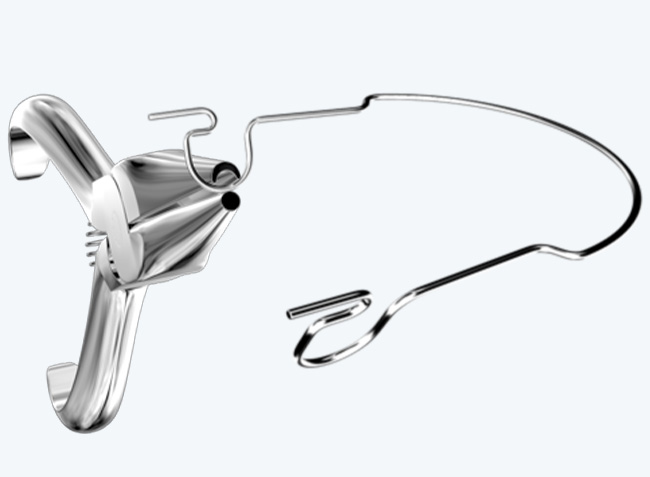
Simple adjustments
are not difficult and generally take less than two minutes to perform.
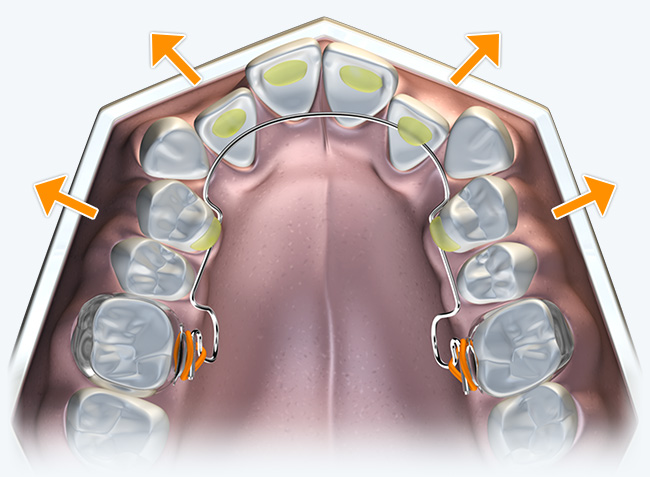
Follows biological principles
to avoid traumatising the midpalatal suture and uses light intermittent forces, minimising root resorption.
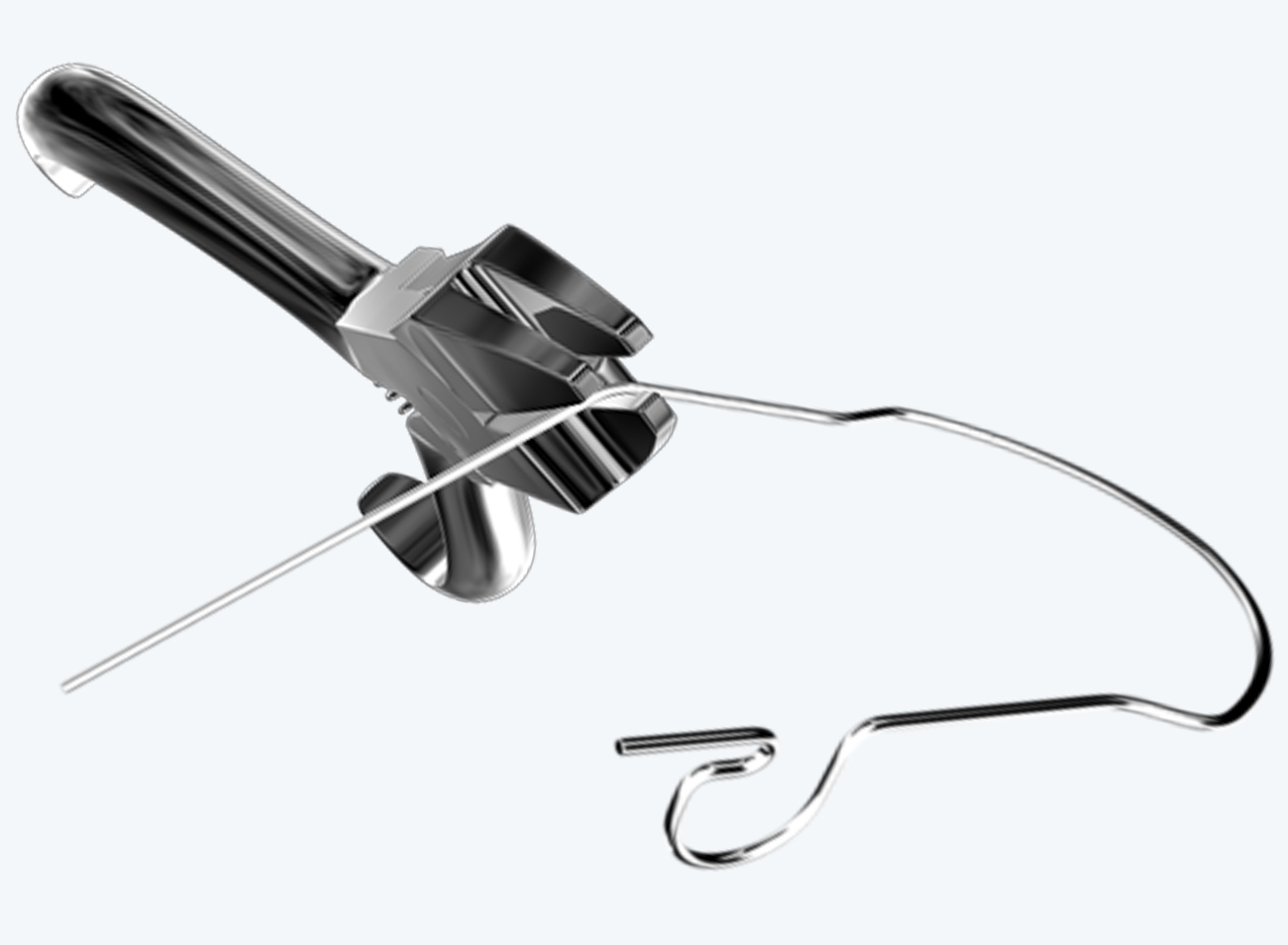
In-house fabrication
can be delegated to an auxiliary staff member and generally made in under five minutes, avoiding laboratory costs.
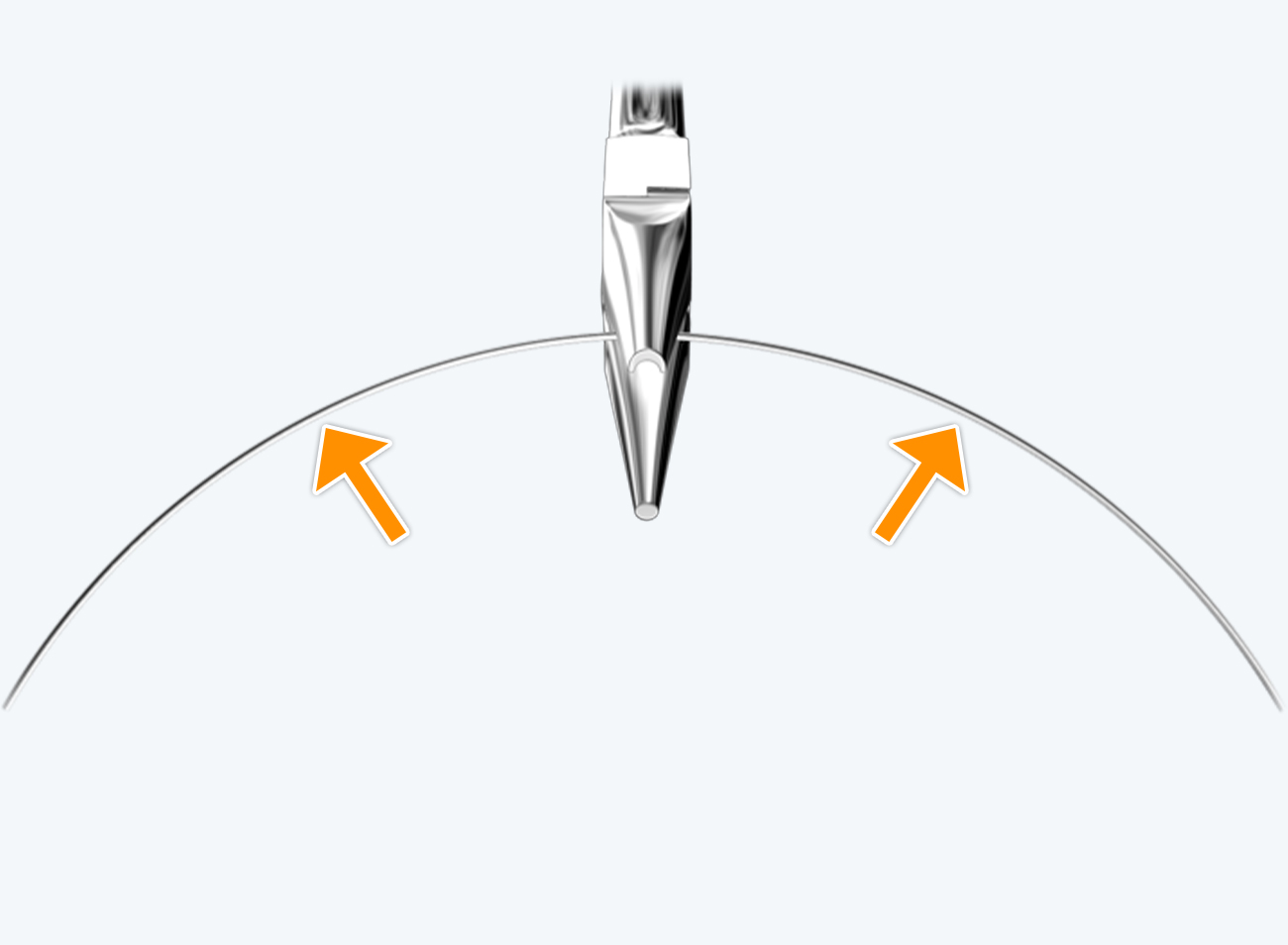
0.7mm low-nickel content wire
stainless steel alloy is flexible, biocompatible and resilient, allowing for more safety and better longevity.
Directions for Use
The BWS can be combined with any of the first stage Myobrace® appliances, but is especially suited to the Myobrace®T1BWS. Once implemented, it is adjusted one to two millimetres by the practitioner every month. After four months of BWS use, the wire is usually removed for one to two months to allow the first molars to return to their optimal position, after which another round of BWS expansion can be undertaken. The BWS must be used when the patient is retaining their Myobrace® appliance overnight as both appliances work in conjunction with each other. Failure to follow these instructions may result in adverse tooth movements.
Instructions for adjustment:
Step 1
Remove the ligatures from around the palatal loops.
Step 2
Remove the BWS from the palatal tubes.
Step 3
Use Adams or half hollow pliers to expand the palatal loops by 1-2mm.
Step 4
Replace the BWS into the palatal tubes and secure with new ligatures.
Step 5
Instruct the patient to wear their first stage Myobrace® appliance (in conjunction with the BWS) for one to two hours while awake and overnight while sleeping. Adjust the BWS again in four weeks.
Important Notice
The BWS requires further training in order to become competent in its use. For more information on the BWS, please complete our advanced online course.
Incorrect usage of the appliance can result in adverse side effects.
Case Studies
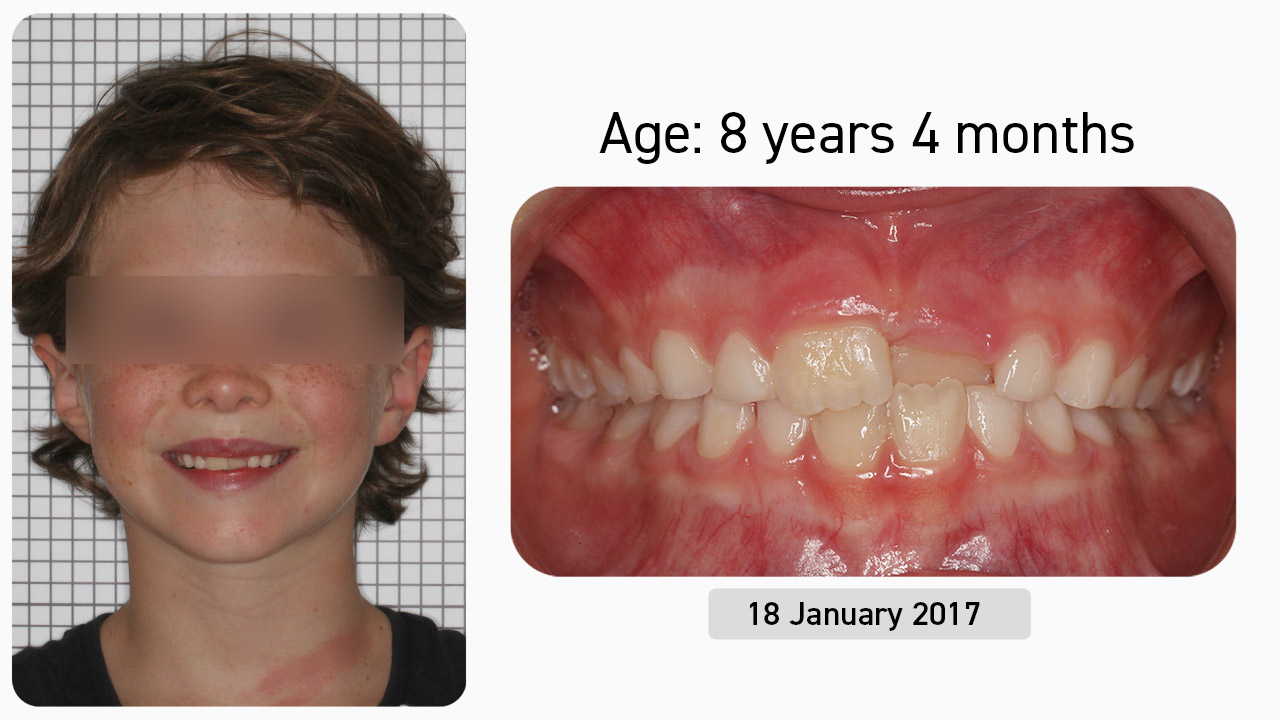
Case Study 1
This eight-year-old male patient presented with the chief complaint of single-tooth crossbite and wanted early intervention. After being presented with the various treatment options, the decision was made to undertake Myobrace® treatment. This involved the use of a series of Myobrace® appliances combined with the Biobloc Stage 1 (BB1) appliance, the BWS arch expansion appliance and Myobrace® Activities.
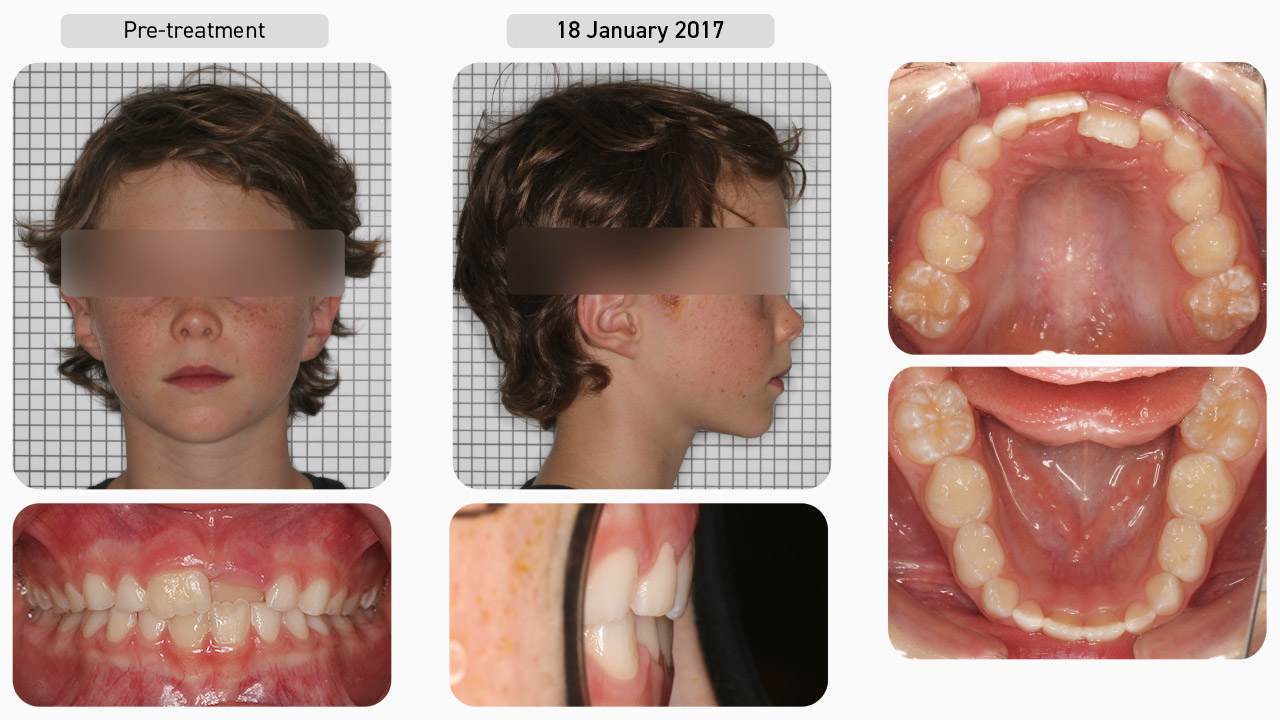
Pre-treatment
Conducting a Myofunctional Orthodontic Evaluation (MOE), we concluded that this patient had an anterior crossbite involving the left-hand side central incisors. The upper and lower jaws were slightly retruded, while the arch forms were narrow and flattened. It was also noted that there was inadequate spacing between the deciduous teeth to accommodate the developing permanent dentition. His poor myofunctional habits included mouth breathing with a low tongue posture and reverse swallow. Since this patient was in the mixed dentition, he was best suited to the Myobrace® for Kids series.
Dental Progression
His treatment began with the K1 appliance to establish nasal breathing and begin the correction of myofunctional habits. Once his breathing function had improved and he was consistently retaining the K1 overnight, the decision was made to use the Biobloc Stage 1 (BB1) appliance to expand the upper arch and create room to accommodate the tongue, as well as help to correct the anterior crossbite. During BB1 expansion, the patient continued to wear the K1 appliance for one hour daily and also continued to work through the Myobrace® Activities program.
Dental Progression
Once upper arch expansion was complete, the BB1 was removed and the patient was issued the K2 appliance to continue arch development and habit correction. A few months later, the decision was made to enter a second round of expansion as the upper arch was still slightly underdeveloped and the upper right lateral incisor had erupted in a rotated position. This time, the BWS was used and, as it must be combined with a first stage appliance, the patient was reissued the K1 during this expansion phase.
Dental Progression
Following the second round of arch expansion, the wire was removed and the patient was reissued the K2 appliance. The patient was then issued the T2 appliance for further arch development, as the T series appliances have a stronger anterior section that the K series. Once the arches were nicely developed and his habits largely corrected, the patient was moved on to the T4 appliance for retention.
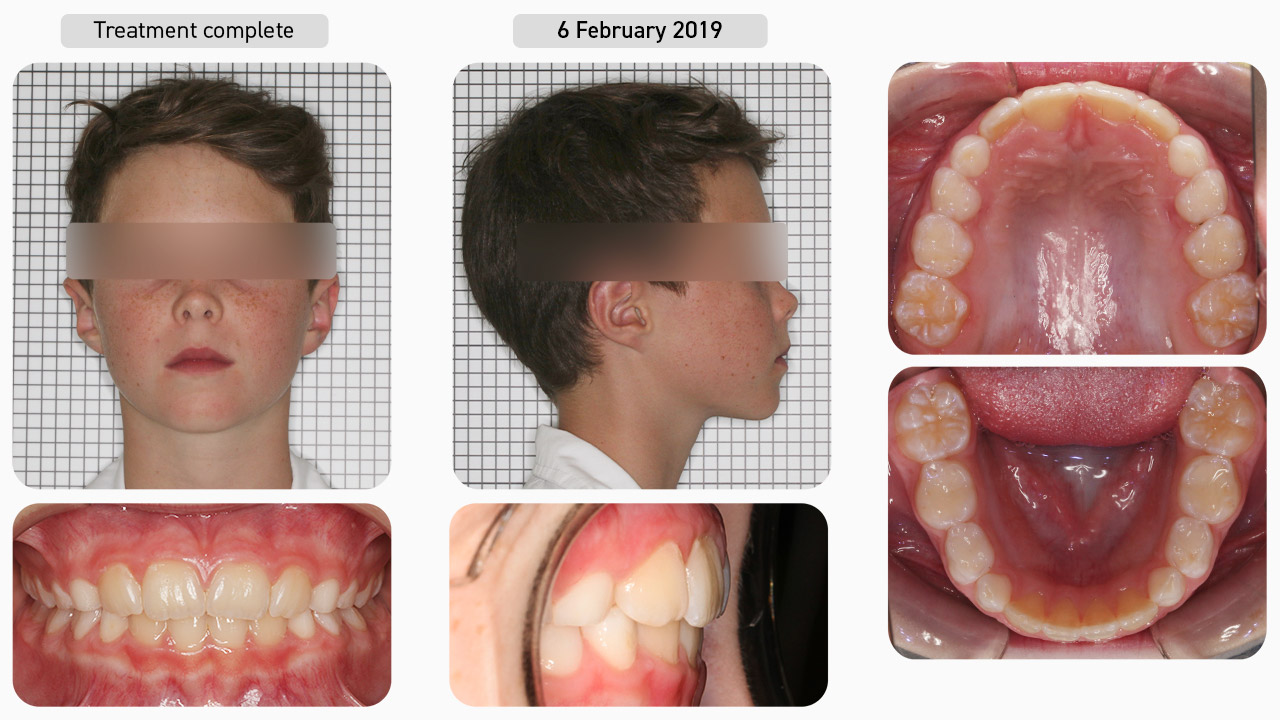
Treatment Complete
Once the goals of Myobrace® treatment had been achieved (correction of breathing and myofunctional habits, arch form and dental alignment), the patient was then entered into the retention phase. This involved continued use of T4 appliance to retain the arch form, alignment and habits, so that his teeth and jaws can continue to develop correctly.
Facial Progression
Once breathing and myofunctional disorders have been corrected, the development of the face can continue in the correct forward and downward direction. This patient's midface and lower face have both developed forwards, which has had positive effects on his breathing patterns and improved facial profile.
Treatment Summary
Using the Myobrace® appliances in conjunction with the BB1 and BWS arch expansion appliances, we have helped this patient to establish nasal breathing, correct his myofunctional habits, and improve the alignment of his teeth. The anterior crossbite has been corrected, the arches are broad and round, and the anterior dental crowding has also been resolved. With the correct breathing and muscle habits established, we can expect further improvements in the teeth and jaws as the patient continues to grow and more permanent teeth erupt into the now well-developed arches.
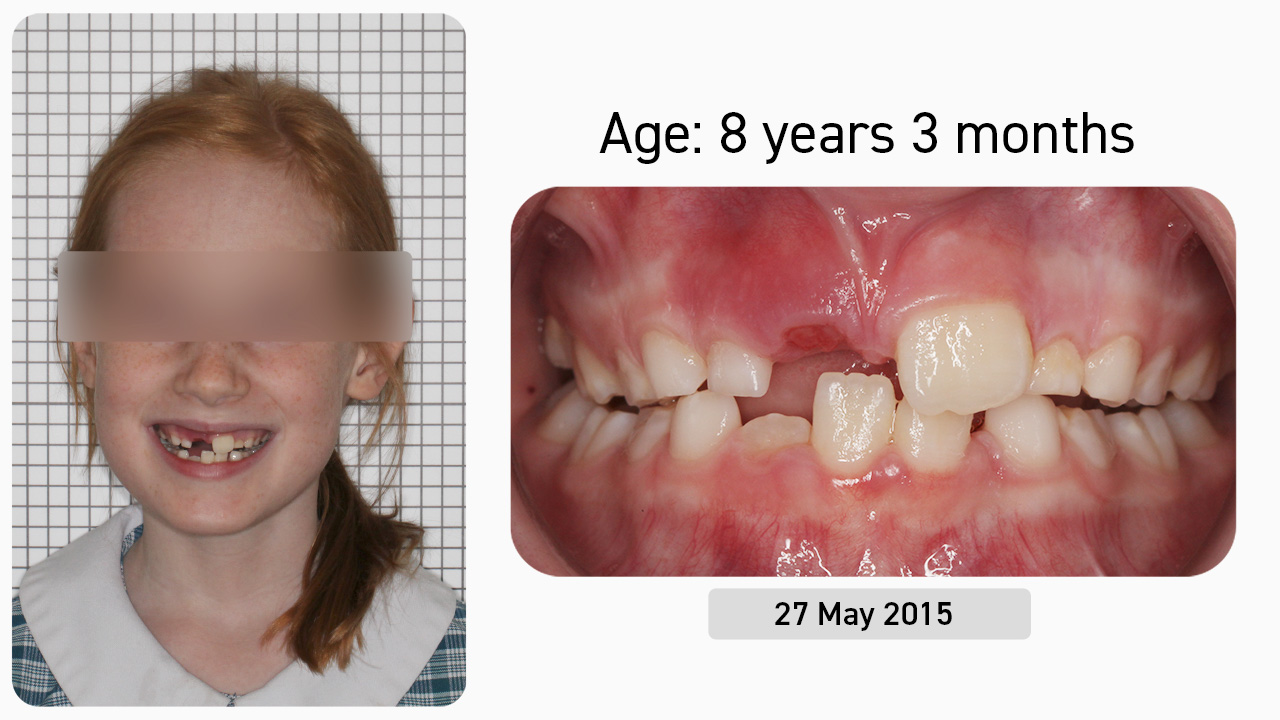
Case Study 2
This eight-year-old female patient presented with the chief complaint of crowding and wanting early treatment in an effort to avoid braces and extractions. After being presented with the various treatment options, the decision was made to undertake Myobrace® treatment. This involved the use of a series of Myobrace® appliances combined with the Biobloc Stage 1 (BB1) appliance and the Myobrace® Activities.
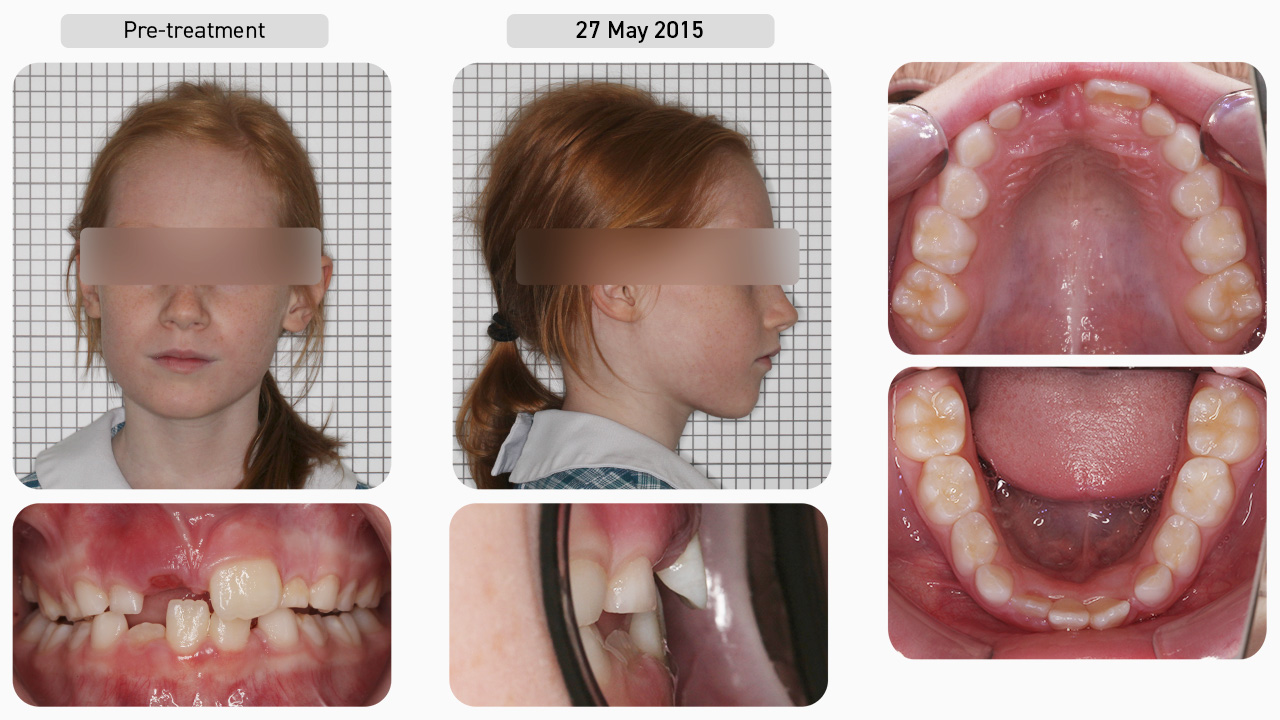
Pre-treatment
Using the Myofunctional Orthodontic Evaluation (MOE) form, we documented that this patient was a vertical grower with a retruded maxilla and backward rotated mandible. She had a deep bite, narrow and flattened arches, tipped in posterior teeth, and there was lost space for the lower left lateral incisor. This patient was a snorer and bruxer, and her poor myofunctional habits included mouth breathing with a low tongue posture and reverse swallow. Since she was in the mixed dentition, her treatment began with the Myobrace® for Kids series.
Dental Progression
She started with the K1 appliance to establish nasal breathing and begin the correction of myofunctional habits. Once her breathing function had improved and she was consistently retaining the K1 overnight, she progressed onto the K2 appliance to focus on arch development and continued habit correction. Look at how the space for the lower left lateral incisor has opened up without the use of any fixed appliances in the lower arch. The decision was then made to use the Biobloc Stage 1 (BB1) appliance to develop the upper arch, while at the same time, approximate the central incisors to close the midline diastema and open up space for the lateral incisors. During BB1 expansion, the patient continued to wear the K2 appliance for one hour daily. Once upper arch expansion was complete, the BB1 was removed and the patient continued on the K2 appliance.
Dental Progression
A few months later, the decision was made to enter a second round of expansion as more forward maxillary development was needed. This time, the BWS appliance was used, and the patient was reissued the K1 appliance for use during this expansion phase. Once complete, the wire was removed and the patient was issued the T3 appliance for final alignment.
Dental Progression
The T3 was used for approximately four months, after which time the patient was issued the T4 appliance for retention. Again, note how space for the lower left lateral incisor was created without the need for any fixed appliances in the lower arch as a result of correcting growth.
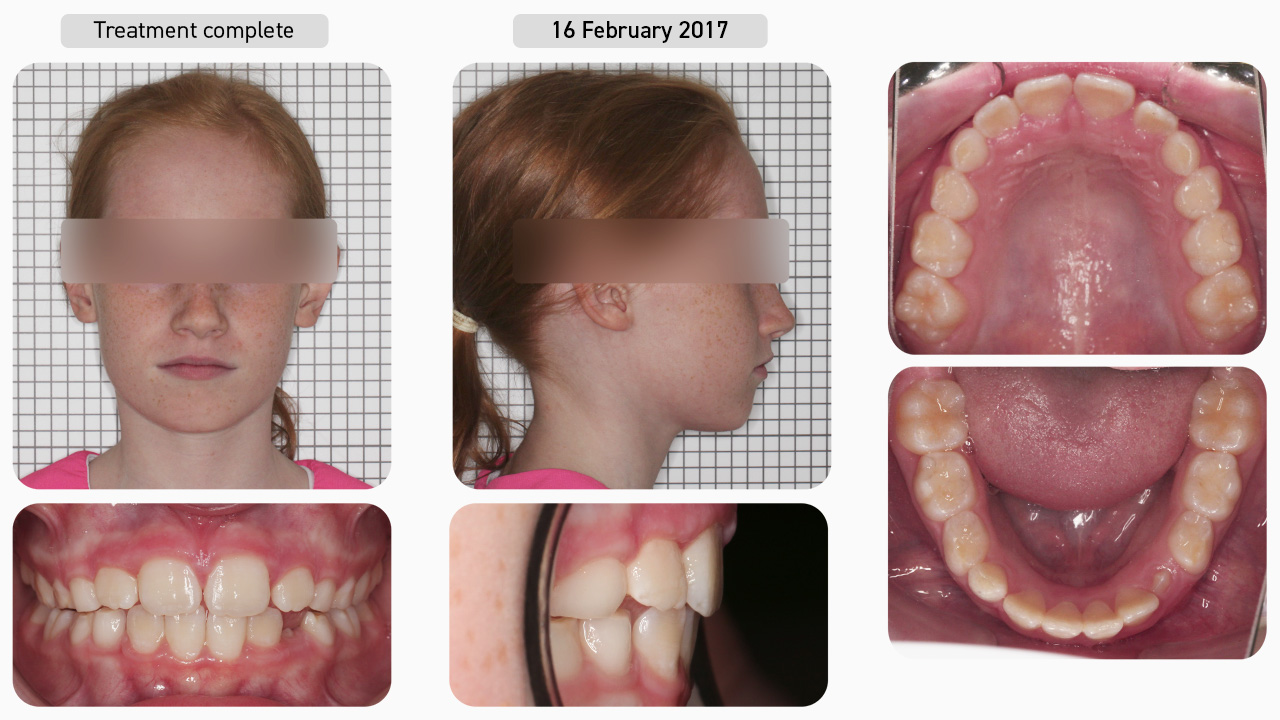
Treatment Complete
Once the goals of Myobrace® treatment had been achieved, correction of breathing and myofunctional habits, arch form and dental alignment, the patient was entered into the retention phase. This involved continued use of the T4 appliance to retain the arch form, alignment and habits, so that her teeth and jaws could continue to develop in the correct manner.
Facial Progression
Once breathing and myofunctional disorders have been corrected, the development of the face significantly improves. The direction of growth for this patient changed from vertical to more horizontal, and both the midface and lower face have developed forwards, having positive effects on the airway. With good breathing and muscle function established, we expect the patient’s remaining development to continue favourably.
Treatment Summary
Using the Myobrace® appliances, in conjunction the BB1, BWS and the Myobrace® Activities, we have helped this patient to establish nasal breathing, correct her myofunctional habits and, therefore, achieve natural alignment of the teeth. The arches are broad and round, the posterior teeth have uprighted, and the dental crowding has resolved. Most importantly, the patient is no longer snoring or grinding. With the correct breathing and muscle habits established, we can expect further improvements in the teeth and jaws as the patient continues to grow and more permanent teeth erupt into the now well-developed arches.
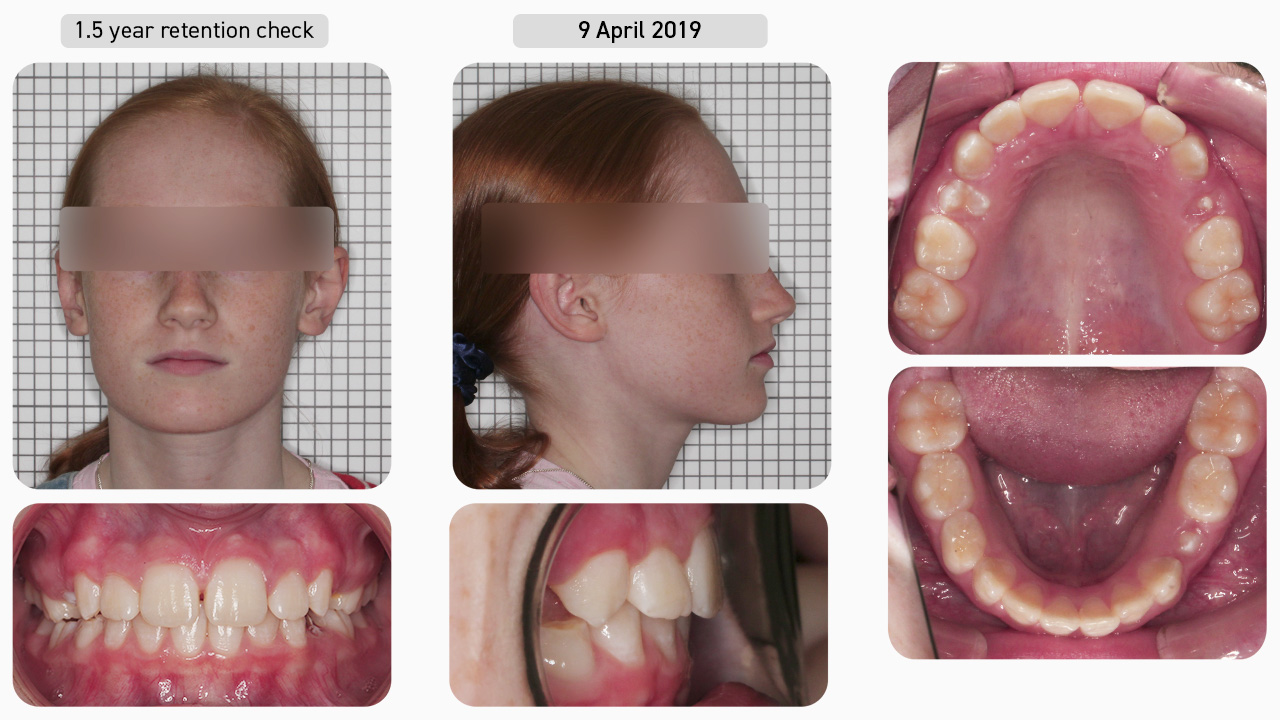
Retention
The patient returned for a retention check approximately one and a half years after treatment was complete and, as you can see, the result has been maintained without the use of any fixed retainers and her growth has continued in a favourable direction. With the correct breathing and muscle habits maintained, we expect good stability of the result ahead.
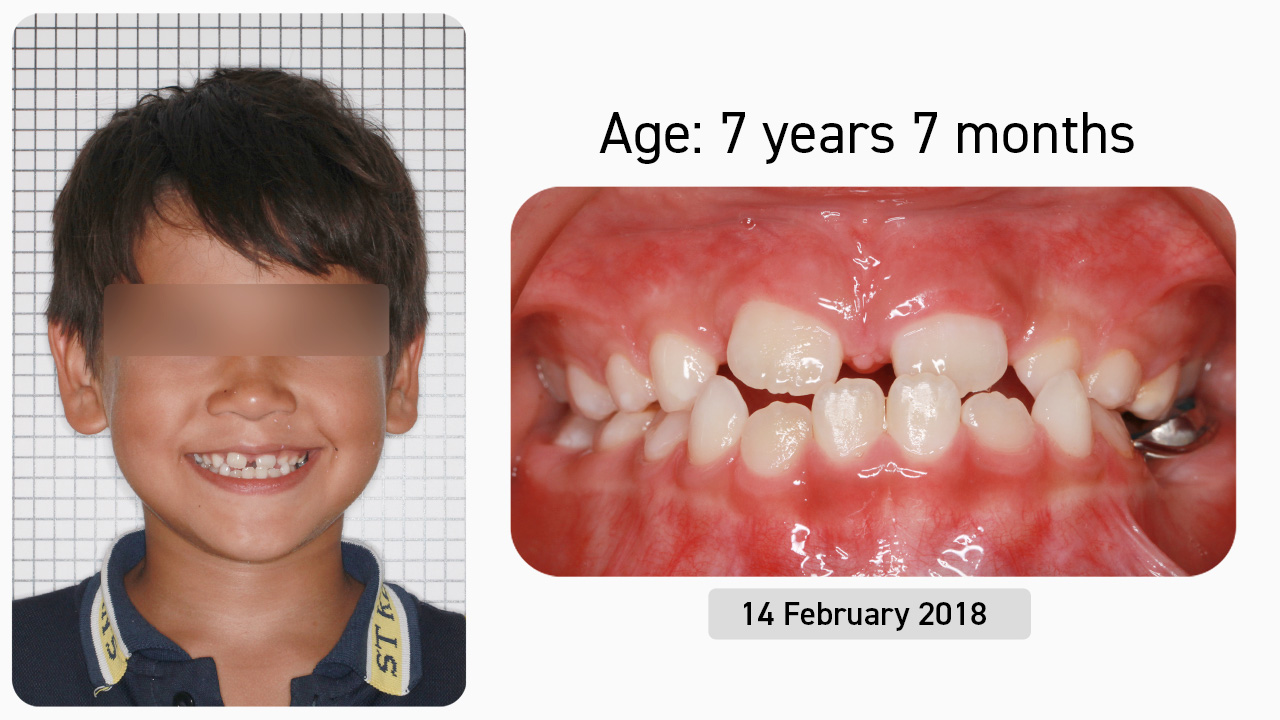
Case Study 3
This seven-year-old male patient presented with the chief complaint of an underbite and wanting to avoid braces. After being presented with the various treatment options, the decision was made to undertake Myobrace® treatment. This involved the use of a series of Myobrace® appliances combined with Myolay™, the Biobloc Stage 1 (BB1) appliance and the Myobrace® Activities.
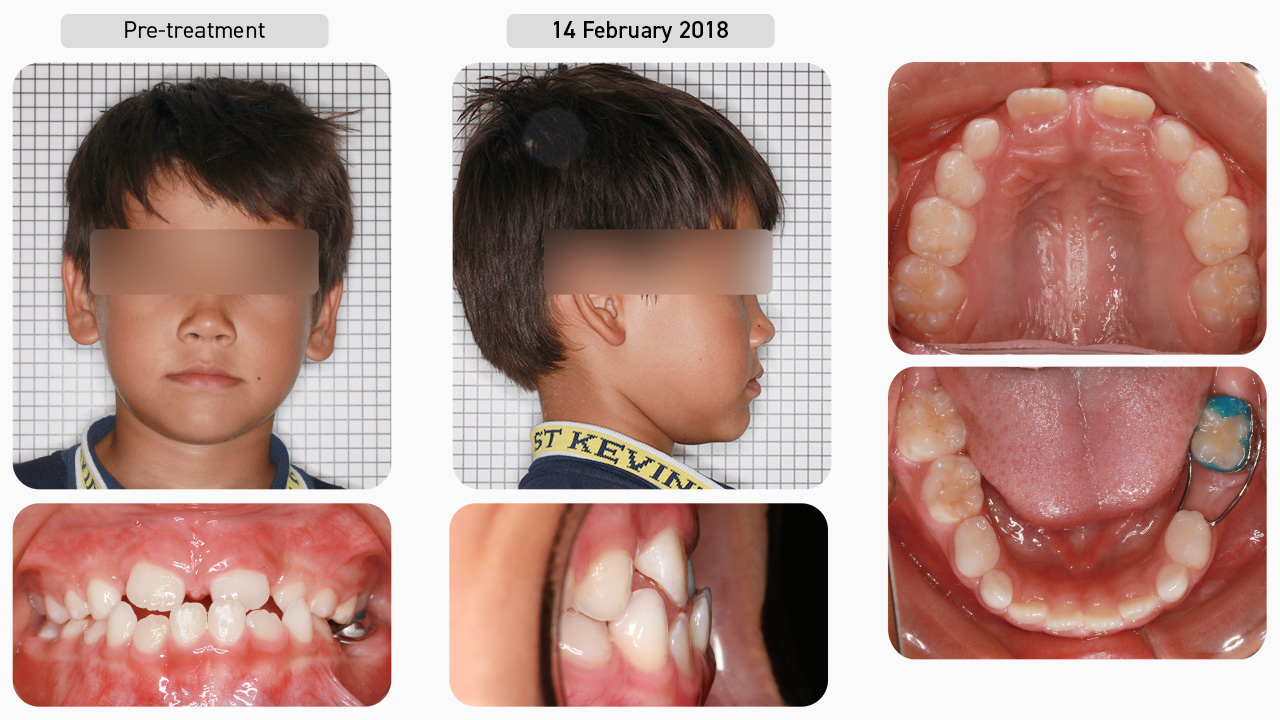
Pre-treatment
Performing a Myofunctional Orthodontic Evaluation (MOE), we documented that this patient had a Class III malocclusion with narrow and flattened arches and moderate to severe dental crowding. His poor myofunctional habits included mouth breathing with a low tongue posture and reverse swallow. Since he was in the mixed dentition with a Class III malocclusion, his treatment began with the Interceptive Class III series.
Dental Progression
He started with the i-3N appliance to establish nasal breathing and begin the correction of myofunctional habits. Six weeks later, his breathing function had improved and he was consistently retaining the i-3N overnight, so he progressed on to the i-3® appliance to focus on arch development and continued habit correction. Myolay™ composite was used to unlock the upper jaw from the lower jaw to further enhance maxillary development. Good compliance with both Myobrace® wear and the Myobrace® Activities saw the upper arch slowly develop forward and, at this point, the anterior teeth were in an edge-to-edge relationship.
Dental Progression
Since the upper arch needed further development to accommodate the tongue and create space for eruption of the lateral incisors, the decision was made to use the Biobloc Stage 1 (BB1) appliance to further expand the upper arch. The BB1 was used to produce both transversal and sagittal expansion, and the central incisors were approximated to close the midline diastema and open up space for the lateral incisors. During BB1 expansion, the patient continued to wear the i-3® appliance for one hour daily. Once upper arch expansion was complete, the BB1 was removed and the patient was issued the P-3® appliance for final alignment and retention.
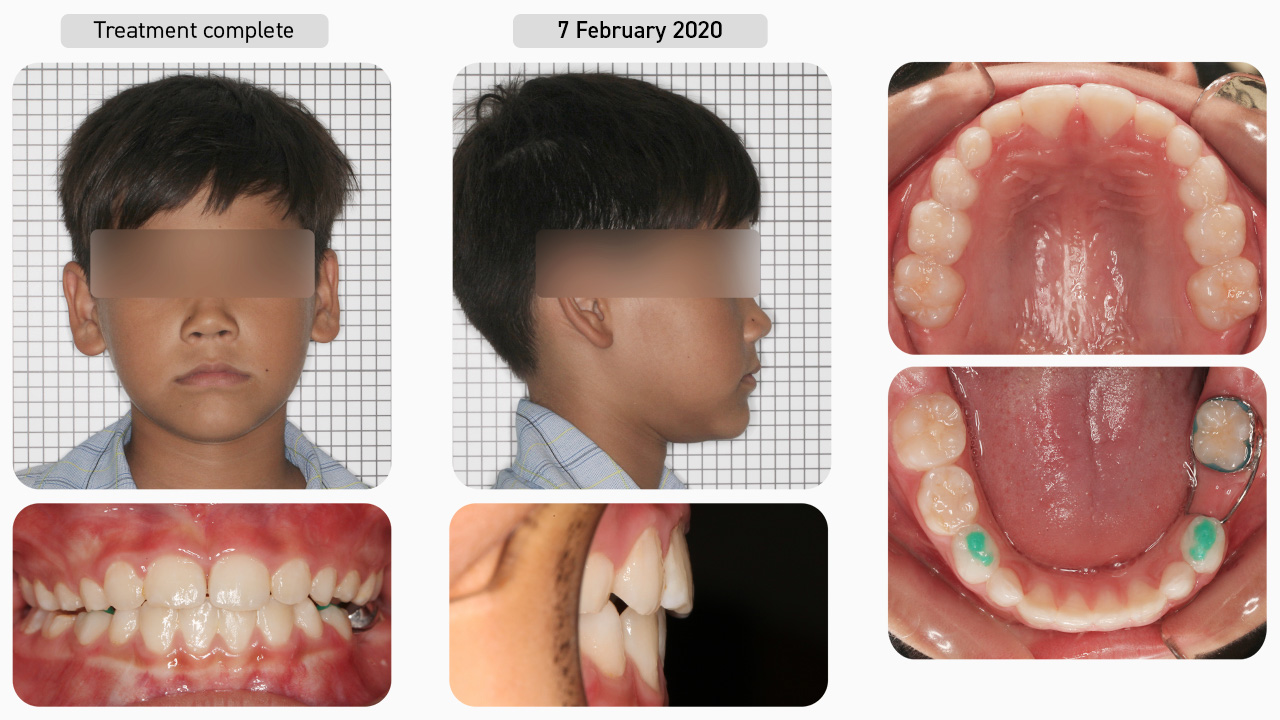
Treatment Complete
With good compliance, the goals of Myobrace® treatment (correction of breathing and myofunctional habits, arch form and dental alignment) were achieved. Following this, the patient entered into the retention phase, continuing on the P-3® appliance to retain the arch forms, alignment and habits, ensuring that he would continue to develop in the correct manner.
Facial Progression
Once breathing and myofunctional disorders have been corrected, the development of the face improves. This patient's midface has developed forwards, improving the oropharyngeal airway. Lip posture has also improved and, with good breathing and muscle function established, we expect the patient’s remaining development to continue in a favourable manner.
Treatment Summary
Using the Myobrace® appliances in conjunction with Myolay™ and the BB1, we have helped this patient to establish nasal breathing, correct his myofunctional habits and, therefore, achieve natural alignment of the teeth. The Class III malocclusion has been corrected, arches are broad and round, and the dental crowding has been resolved. With the correct breathing and muscle habits established, we can expect further improvements in the teeth and jaws as more permanent teeth erupt and the patient continues to grow.
Resources
BWS Patient Instructions
Downloadable pdf document with instructions specifically for the BWS.
Download ResourceMyobrace® Appliance Catalogue
Downloadable pdf document detailing the Myobrace® appliance range.
Download ResourceInterested in learning about MRC's arch development techniques?
Our BWS course explains the crucial role arch development plays in improving breathing and myofunctional disorders for patients with orthodontic and TMJ issues.
START OUR BWS COURSE